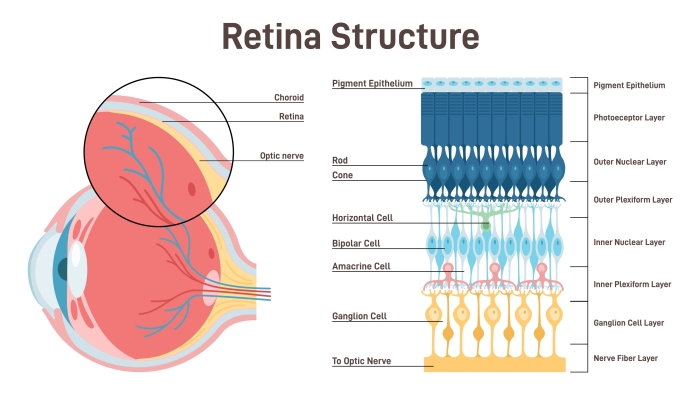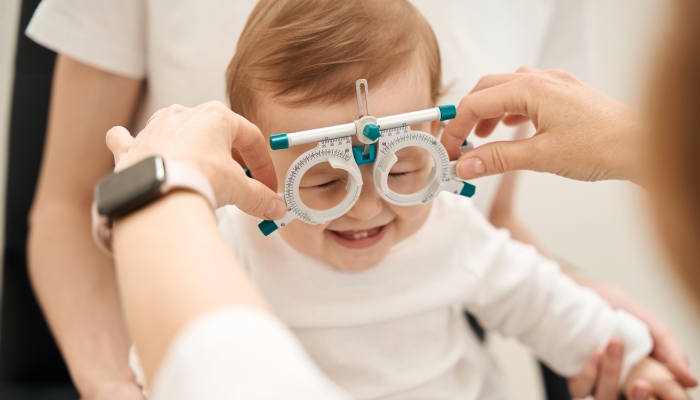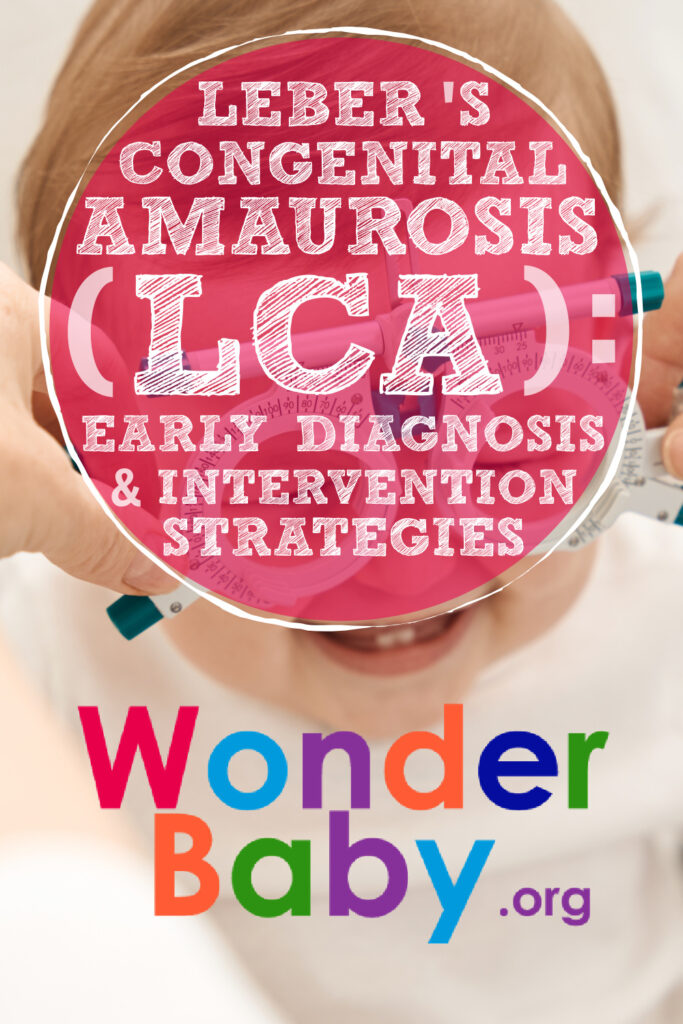Leber’s Congenital Amaurosis (LCA): Early Diagnosis and Intervention Strategies

- Leber’s Congenital Amaurosis is a disease in which the retina of affected infants develops incorrectly, leading to severe visual impairment.
- LCA is one of multiple inherited retinal diseases and must be passed down by both parents for the child to have it.
- The genes responsible for LCA can be detected in parents and their children with specialized testing and are part of how children are officially diagnosed with LCA.
- Visual aids can help children adapt to their level of vision loss, and support groups help parents and children deal with the realities of LCA.
- Several clinical trials using gene therapy have shown promising results for helping stop LCA progression.
One of the factors that affects your child’s eye development and visual function is the genes they inherit from each parent. Normal genes will work together to create a functioning eye. Unfortunately, abnormal genes can be passed on and can disrupt your child’s eye development. In Leber’s Congenital Amaurosis, mutated genes cause the retina to develop improperly and can lead to severe vision loss or blindness.
What Parents Need to Know About LCA
The human eye is made up of multiple parts, including a layer of tissue at the back of the eye called the retina.

During human retinal development, photoreceptor cells, or light receptors, called cones and rods, are created. These light receptors catch incoming light and convert it into an electric signal. This electrical signal is then carried via the optic nerve to the brain to create an image.
Disruptions to the development of cones and rods will affect retinal function. A group of eye disorders under the umbrella name of “inherited retinal dystrophy” can cause this disruption and are passed down from the parents to the child. The most severe form of these diseases is called Leber’s Congenital Amaurosis.
With Leber’s Congenital Amaurosis, the mutated genes lead to an improperly formed retina that can’t process the light coming into the eye correctly, which leads to a decreased visual response. This decreased response equates to functional vision loss.
Clinical Presentation

Leber’s Congenital Amaurosis occurs in 1 of 30,000 to 81,000 children. Although rare, it is the leading cause11. Huang, C.-H., Yang, C.-M., Yang, C.-H., Hou, Y.-C., & Chen, T.-C.. Leber’s Congenital Amaurosis: Current Concepts of Genotype-Phenotype Correlations. Genes. 2021;12(8), 1261. https://doi.org/10.3390/genes12081261 of childhood blindness.
Multiple gene mutations cause LCA and what genes are affected will change the severity of the disease and how it presents itself.
While your child’s symptoms may present differently, some typical manifestations include:
- Nystagmus (involuntary eye movements)
- Photophobia (sensitivity to light)
- Poor or absent night vision
- Delayed pupillary response (the pupils may take a while to dilate when a light is shined in the eyes)
Early Detection and Diagnosis for Leber’s Congenital Amaurosis

Although your infant isn’t able to talk to you, there are noticeable signs in infants with Leber’s Congenital Amaurosis. These include:
- Your child is not responding to visual cues
- Your child frequently pressing on their eyes with their hands or feet
- A sunken look to your child’s eyes from the frequent pressing
Genetic Testing
Since Leber Congenital Amaurosis is a genetic disease, testing for you and your children is of the utmost importance.
LCA is an autosomal recessive disease, meaning that both biological parents must pass on a defective gene to the child to contract LCA. If you are trying for a child, you can do genetic testing to see if you and/or your partner carry the mutated genes necessary for LCA.
If you’re unsure if your child is exhibiting signs of LCA, testing will help your child’s pediatrician and ophthalmologist pin a diagnosis down. A particular type of testing called molecular gene testing can help correctly diagnose LCA, while other genetic tests22. Dumitrescu, A., Epley, D., Hao Tang, P., Levin, M., Tripathy, K., Moshfeghi, A., Prakalapakorn, S. G., Grigorian, P., & Vasamsetti, A.. Leber Congenital Amaurosis. EyeWiki. 2023. https://eyewiki.aao.org/Leber_Congenital_Amaurosis can tell which particular genes are mutated.
Electroretinogram (ERG)

A standard eye exam for your child is recommended at six months of age but will not be enough to see if your child truly has Leber’s Congenital Amaurosis. An electroretinogram is a necessary test to help ensure it truly is LCA.
An electroretinogram is a procedure where retina specialists numb your child’s eye, attach an electrode to the eye, and test the retina’s response to light with flashing lights. This test normally takes around an hour, and while it is not painful, the electrode can produce a foreign body sensation in the eye that can be annoying.
Since other diseases could affect your child’s visual acuity, ERGs are an important part of the differential diagnosis. Healthy retinas will show activity on an ERG in response to light, while retinas affected by Leber’s Congenital Amaurosis will show diminished or no activity on an ERG.
Intervention Strategies for Children With LCA
While there is no definitive cure for Leber’s Congenital Amaurosis at this time, there are ways to help either prevent or deal with the realities of your child suffering from LCA.
Genetic Counseling

Whether you are a prospective parent or already a parent, genetic counseling is a great option.
Genetic testing before trying to get pregnant can help you and your partner make an informed decision about having a baby in regards to your child’s chances of having Leber’s Congenital Amaurosis. If your child is already born, testing can help you find out if your child has the mutated genes for LCA. Knowing your child has LCA can help your pediatrician and ophthalmologist adjust your child’s plan of care.
Visual Aids and Assistive Technologies

Your child’s vision loss can alter how they go about their daily activities. Thankfully, there are a variety of low vision aids available to help assist your child depending on their visual acuity. These tools include:
- Magnifiers
- Braille
- Text-to-speech devices
- Orientation and mobility training
The tools utilized will depend on how good your child’s vision is. Some of these tools, like orientation and mobility training, may also require a specialist. Talk to your pediatrician about getting in touch with the right people for these therapeutic interventions.
Clinical Trials and Emerging Therapies

In the world of molecular genetics, clinical trials have started showing promising results for the beginnings of gene replacement therapy33. Sharif, W., & Sharif, Z.. Leber’s congenital amaurosis and the role of gene therapy in congenital retinal disorders. International Journal of Ophthalmology. 2017;10(3), 480–484. https://pubmed.ncbi.nlm.nih.gov/28393043/ for children suffering from Leber’s Congenital Amaurosis.
Gene therapy uses modified DNA that is inserted into the target organ to help replace or inactivate genetic mutations. By doing so, you can help stop or even reverse the progress of the disease, depending on the disease.
There are still a lot of limitations to gene therapy, however. LCA is caused by one or more specific genetic mutations, and the current gene therapy only applies to a small number of LCA genes. This means if your child’s LCA is caused by an altered gene that isn’t currently “fixed” with gene therapy, then it is not an option.
Also, while visual improvement is a possibility with gene therapy, it is not guaranteed. It could halt the progress of retinal degeneration or not affect it at all.
There is still much to learn from gene therapy trials, like what the best age to deliver therapy is or how long will it be effective before needing more intervention.
Coping With LCA Diagnosis

With as severe as Leber Congenital Amaurosis can be, it is important to remember to counteract the toll it takes on you and your child.
Counseling and Therapy
You or your partner may have a lot of feelings about raising a child with a visual impairment or finding out that you carry the genes for LCA. It’s important to remember to talk to each other about how you may be feeling. You may find that getting counseling or therapy may help you or your partner explore these feelings.
Don’t forget to check in with your child and see how they are feeling, too. Your love and support as a parent will help your child build resiliency as they deal with a chronic illness like LCA. Therapy may be an option for them if they are having emotional issues dealing with the problems of LCA.
Support Groups and Communities
Ask your pediatrician about any local communities and resources for families of those dealing with Leber’s Congenital Amaurosis and vision loss.
The Foundation Fighting Blindness44. Foundation Fighting Blindness. fightingblindness.org. https://www.fightingblindness.org is an online foundation dedicated to promoting research for inherited retinal dystrophies. The website is a treasure trove of information, including stories, resources, and education about retinal diseases.
FAQs
How do schools and educational institutions typically accommodate children with LCA, and what should parents advocate for?
The specific educational needs of your child with LCA may vary from other affected children, just like the resources available will vary from school to school. Regardless, talking with your child’s school and seeing what resources are available will be an important first step.
If your child’s school cannot accommodate your child’s low vision issues, then there is the option of a school for the blind. Schools for the blind are specially designed to accommodate the needs of the visually impaired.
However, depending on your state, the school for the blind may be very far away and not feasible to enroll your child in. You may be able to contact your state’s Department of Education to see if they have special teams that can help bring accommodations to your child.
References
- Huang, C.-H., Yang, C.-M., Yang, C.-H., Hou, Y.-C., & Chen, T.-C. (2021). Leber’s Congenital Amaurosis: Current Concepts of Genotype-Phenotype Correlations. Genes, 12(8), 1261. https://doi.org/10.3390/genes12081261
- Dumitrescu, A., Epley, D., Hao Tang, P., Levin, M., Tripathy, K., Moshfeghi, A., Prakalapakorn, S. G., Grigorian, P., & Vasamsetti, A. (2023, October 12). Leber Congenital Amaurosis. EyeWiki. https://eyewiki.aao.org/Leber_Congenital_Amaurosis
- Sharif, W., & Sharif, Z. (2017). Leber’s congenital amaurosis and the role of gene therapy in congenital retinal disorders. International Journal of Ophthalmology, 10(3), 480–484. https://pubmed.ncbi.nlm.nih.gov/28393043
- Foundation Fighting Blindness. fightingblindness.org. (n.d.). https://www.fightingblindness.org

The information WonderBaby provides is not intended to be, and does not constitute, medical or other health advice or diagnosis and should not be used as such. Always consult with a qualified medical professional about your specific circumstances.
Related Posts

Eye Conditions and Syndromes, Visual Impairment
Neuralink Announces Plans to Restore Sight to the Blind with Brain Chip
Elon Musk’s company Neuralink has announced plans to begin human trials of its new “Blindsight” brain chip by the end of 2025.

Visual Impairment
The Gift of Understanding: How a Young Child Helps His Blind Father Navigate Life
When a parent is blind, it’s natural for people to wonder how their sighted child will adapt. Will they struggle to understand their parent’s needs? Will they feel burdened by...

Braille and Literacy, Toys, Visual Impairment
24 Braille Toys for Kids Who are Blind
Everything from alphabet blocks to raised line coloring pages and activity books to puzzles to card and board games... and so much more! And it's all in braille ready for...